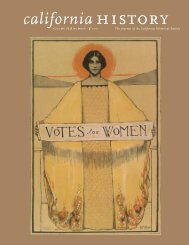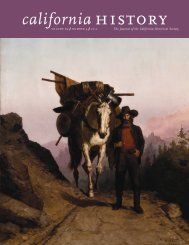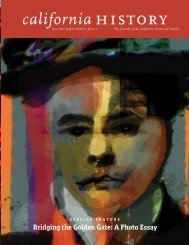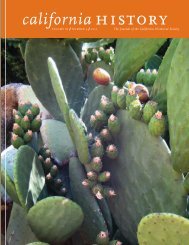Volume 90, Number 1 - California Historical Society
Volume 90, Number 1 - California Historical Society
Volume 90, Number 1 - California Historical Society
You also want an ePaper? Increase the reach of your titles
YUMPU automatically turns print PDFs into web optimized ePapers that Google loves.
42<br />
rancher’s domain became an attraction for both<br />
the anonymous tourist and the aspiring artist.<br />
Witty, for the most part, gregarious, egoistic but<br />
also strongly idealistic, Joaquin Miller and his<br />
Hights—the name he gave his acreage—were<br />
major players in Oakland’s lively, turn-of-thelast-century<br />
cultural scene.<br />
SoCial CliMbing<br />
When, in the spring of 1887, Miller purchased<br />
his piece of the Contra Costa hills, he was an<br />
acclaimed poet with multiple books and four<br />
plays to his name. At the age of ten, Cincinnatus<br />
Hiner Miller, as he was named, moved with his<br />
family from Libertyville, Indiana, to Oregon.<br />
Thirty years later and an aspiring writer, this child<br />
of the Wabash River and the Conestoga wagon<br />
became the sensation of the drawing rooms of<br />
London. Sporting long hair and a Wild West outfit<br />
of sombrero, scarlet shirt, scarf, and sash, the<br />
onetime gold miner, Indian fighter, Pony Express<br />
rider, newspaper publisher, and judge captivated<br />
the haute monde of Britain. A dozen years before<br />
William Cody’s Buffalo Bill show packaged the<br />
mythos, this self-called Byron of the Rockies<br />
introduced an old-world audience to the romance<br />
and adventure of the western frontier.<br />
Having acquired his Oakland holding, Miller<br />
built a tiny log hut as temporary shelter. At this<br />
phase of his life, he would amass an amorphous<br />
total of three wives and seven, mostly absent,<br />
children (two, however, soon showed up, causing<br />
no end of trouble). 5 His third spouse, Abbie<br />
Leland Miller, was back in New York, where,<br />
along with Newport or Saratoga Springs, she preferred<br />
to remain. 6 Several factors eased Miller’s<br />
plan to settle permanently in northern <strong>California</strong>.<br />
Having lived in the Shasta/Siskiyou areas on and<br />
off between 1853 and 1859, he knew the wilds of<br />
that part of <strong>California</strong>. Subsequent visits to San<br />
Francisco in 1863, 1870, and again in 1871–72,<br />
<strong>California</strong> History • volume <strong>90</strong> number 1 2012<br />
combined with some early writing, had laid down<br />
tracks for an eventual return. In the 1870s and<br />
1880s, his prodigious output during his residency<br />
in Europe and on the East Coast had distinguished<br />
this frontiersman as one of the West’s<br />
most prolific writers. Along with his adventurous<br />
life, in the sixteen years (1870–86) preceding his<br />
return, he had produced six books of poetry, four<br />
novels, two works of romanticized nonfiction,<br />
and ten plays, only two of which were actively<br />
produced. Of those two, The Danites in the Sierras<br />
was both a Broadway and a London success (it<br />
was performed in London by the first American<br />
troupe to travel abroad). Two collections of verse,<br />
Pacific Poems (London, 1871) and Songs of the Sierras<br />
(London and Boston, 1871), had even earned<br />
the Oregonian a <strong>California</strong> title, namely, Poet of<br />
the Sierras. 7 All of this acclaim had the beneficial<br />
effect of securing Miller a job in advance of his<br />
arrival. Harr Wagner, the new editor of a revived<br />
Golden Era magazine, had offered the Washington,<br />
D.C.–based Miller the position of associate<br />
editor. This allowed him to pick up way ahead of<br />
where he left off.<br />
Miller’s cumulative achievements, combined<br />
with his bonhomie, made him a natural candidate<br />
for one of San Francisco’s leading social<br />
fraternities, the Bohemian Club. Founded in<br />
1872 by a group of journalists, this society had<br />
expanded early on to include artists and their<br />
patrons. By 1888, Miller had joined Mark Twain,<br />
Oliver Wendell Holmes, Charles Warren Stoddard,<br />
and Ina Coolbrith as an honorary member.<br />
(His continuation in that status may be explained<br />
by both his early fame and his persistent state<br />
of penury.) According to an account by the neophyte<br />
journalist Elodie Hogan, this membership<br />
paid immediate dividends. A few of Miller’s club<br />
mates contributed their talents to the construction<br />
of the Abbey, the chapel-like cottage that the<br />
writer built for himself while living in the log<br />
hut at the Hights. One, possibly Martinez native<br />
and man-about-the-arts Bruce Porter, fashioned









